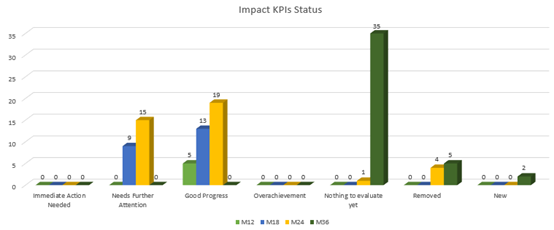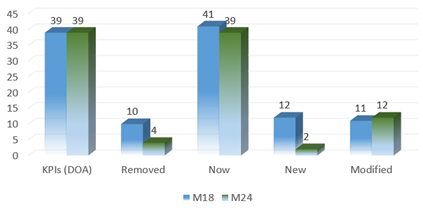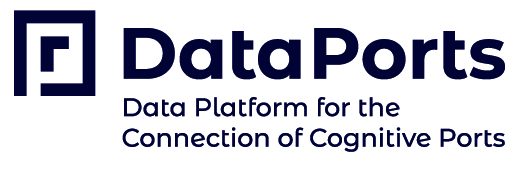The second deliverable that reports the impact and outreach results is available.
The ambition of deliverable (D6.8) is to provide the progress, the current status and the assessment of each Impact Key Performance Indicators (KPI), which were presented in DoA and redefined in D6.3, and propose necessary adjustments to fit with the scope of the project and the port pilots, as these are defined by now.
Through the Impact KPIs that were initially presented in DoA, DataPorts aims to measure its impact to the seaport community, along with its level of adoption, not only by the seaports, but also for every involved to be party and therefore contributing to the objective ICT13-2019: “Supporting the emergence of data markets and the data economy”. DataPorts addresses equally strategic high-level goals set by the European Union, as well as practical stakeholders’ and end users’ needs related with data platforms, data markets and the data economy. DataPorts reflects Europe willingness to create and offer integrated data platforms within and across different application domains. KPIs are originally designed to have an impact on the European Union seaports transportation relevant agents (e.g., Port Authorities; shipping companies or infrastructure integrators and operators) and to provide integrated, secure, private and interoperable data related services.
Impact KPIs are reviewed and evaluated based on the progress of their execution plan and are dependent on the progress of each Work Package (WP) in order for WP teams to have the chance to fine tune – or change course entirely. KPIs of DataPorts are not static and therefore, there is always a need to evolve, update and modify as needed, otherwise the risk of not fulfilling a KPI is increased. This monitoring and evaluation process resulted in the KPIs’ continuous adjustments, such as, removing KPIs, replacing them with a more realistic ones, or adding new ones. The current status and their progress can be seen in the Figure below.

From the course of actions of Dataports, and the analysis of the impact requirements, it was deemed necessary to change the Impact KPIs described in DoA, in order to be more realistic and feasible. For this reason, new KPIs are proposed which are in line with the objectives of the project. In June 2021, 3 Impact KPIs were redefined, while 10 KPIs were deemed necessary to be deleted because they would not be measurable within the duration of the project. With the progress of the project as depicted in the next Figure, KPIs are continued to be modified addressing the needs of the pilots and the partners involved.

Moreover, establishing various forms of collaboration with external stakeholders will increase the adoption rate of DataPorts platform by them. Different approaching procedures regarding this were introduced in D6.1. Under this scope, surveys are not only a feedback mechanism but also a medium for promoting DataPorts activities.
Under this concept was the workshop that OTE an industry partner and CERTH, a technology provider, co-organised with Ammitec (Association of Maritime Managers for Information Technology and Communications) on Blockchain in Maritime, described in D6.3, presented in D6.4 and the results will be reported in D6.10. In the remaining months an emphasis will be given by DataPorts partners in organising workshops with local seaports’ communities and potential stakeholders, beneficiaries of DataPorts platform.
Through the annually conducted surveys, the impact of the DataPorts activities will be highly dependent on the results extracted from the surveys. The responses collected from the surveys will offer valuable insights for DataPorts. They will also be a valuable source to measure the actual impact of the designed data platform, at different implementation stages and through this evaluation, give valuable insights in terms of the data platform’s functionality and its usage.
The 2nd survey was under the title “DataPorts Components and Functionality Validation” (available in Annex #1). The purpose was to evaluate the functionality and usability of the components/services that were recently introduced. The target group was IT Experts / Consultants from DataPorts organisations and mainly from OTE, since it is the DataPorts partner organisation with a wide range of expertise and the larger IT department. The responses will help integrators to improve their components, if necessary, in order to meet the future users’ needs. A supportive material of demonstration videos and informative documentation accompanied the questionnaire, in order responders to be familiar with the concept of DataPorts.
The survey was divided into two main categories, the Data Governance Services, the Data Processing Services, and the Data Analytics Services. Each one of them contained questions for several DataPorts components / services, such as, the Blockchain for Data Sharing (Container Pick-Up Solution and Verified Gross Mass solution), the Data Abstractions & Virtualisation, the Data Access, the Semantic Interoperability, the Process Based Analytics and the Automatic Model Training Engine.
All this information is available here.
